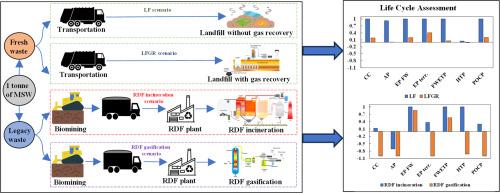Waste-to-energy pathways for fresh and legacy waste management: A case study in India
IF 9.5
Q1 ENERGY & FUELS
引用次数: 0
Abstract
Rapid urbanization and population growth in developing countries like India have led to the dual challenge of managing the fresh municipal solid waste (MSW) and accumulated legacy waste in unregulated landfills. Despite the environmental significance of legacy waste, it is often overlooked in existing life cycle assessment (LCA) studies. This results in a critical gap in integrated LCA approaches that consider both waste streams within a single system boundary. This study addresses this gap by conducting an integrated attributional LCA, using the case study of Ghazipur landfill, Delhi, India. It covers processes from waste collection to energy recovery, using a functional unit of 1 tonne of MSW. LCA is performed using GaBi software and the Environmental Footprint 3. Four scenarios are analyzed: landfill without gas recovery (LF), landfill with gas recovery (LFGR) for fresh waste, and refuse-derived fuel (RDF) incineration, RDF gasification for legacy waste. LFGR shows an energy recovery of 73.04 kWh/tonne of MSW, significantly reducing the environmental impacts compared to LF. For legacy waste, RDF gasification outperforms incineration, showing an energy recovery of 306.1 kWh/tonne of MSW. The reduction cost of 1 tonne of CO2 is 20 USD for LFGR and 32 USD for the RDF gasification. Sensitivity analysis highlights that the net electricity output predominantly affects the climate change category. This study highlights the potential of WtE for biomining and landfill reclamation, supporting circular economy transitions. The integrated LCA framework is replicable across developing nations with similar landfills, aligning with SDGs 7, 11, and 13.

新废物和遗留废物管理的废物转化能源途径:印度案例研究
在印度等发展中国家,快速的城市化和人口增长带来了管理新鲜城市固体废物(MSW)和在不受监管的垃圾填埋场中积累的遗留废物的双重挑战。尽管遗留废物具有重要的环境意义,但在现有的生命周期评价(LCA)研究中,它往往被忽视。这导致综合LCA方法在单一系统边界内考虑两种废物流的关键差距。本研究利用印度德里Ghazipur垃圾填埋场的案例研究,通过进行综合归因LCA来解决这一差距。它涵盖从废物收集到能源回收的过程,使用1吨都市固体废物的功能单位。LCA是使用GaBi软件和环境足迹3执行的。分析了四种情况:无气体回收填埋(LF)、新鲜废物的气体回收填埋(LFGR)以及遗留废物的垃圾衍生燃料(RDF)焚烧、RDF气化。LFGR的能量回收率为73.04 kWh/t MSW,与LF相比显著降低了对环境的影响。对于遗留废物,RDF气化优于焚烧,显示每吨城市固体废物的能量回收率为306.1千瓦时。LFGR每吨CO2的减排成本为20美元,RDF气化每吨CO2的减排成本为32美元。敏感性分析表明,净发电量主要影响气候变化类别。该研究强调了WtE在生物采矿和垃圾填埋场回收方面的潜力,支持循环经济转型。综合LCA框架可在拥有类似垃圾填埋场的发展中国家复制,符合可持续发展目标7、11和13。
本文章由计算机程序翻译,如有差异,请以英文原文为准。
求助全文
约1分钟内获得全文
求助全文
来源期刊

Energy nexus
Energy (General), Ecological Modelling, Renewable Energy, Sustainability and the Environment, Water Science and Technology, Agricultural and Biological Sciences (General)
CiteScore
7.70
自引率
0.00%
发文量
0
审稿时长
109 days
 求助内容:
求助内容: 应助结果提醒方式:
应助结果提醒方式:


